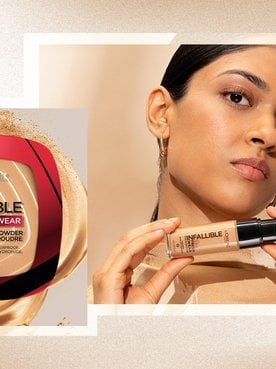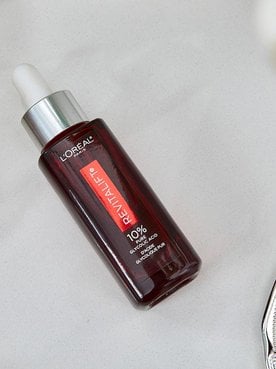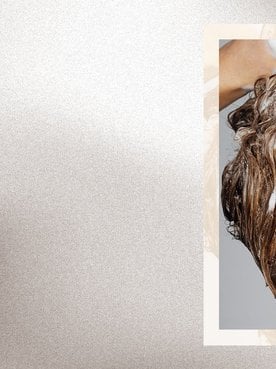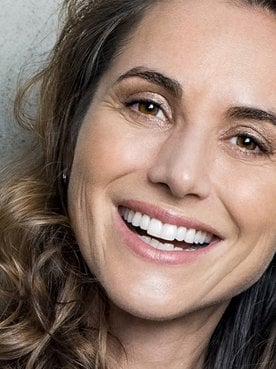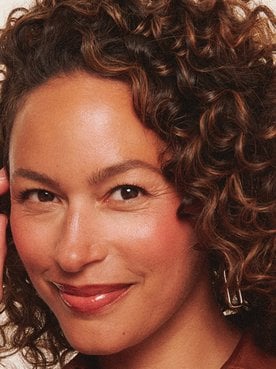You might be able to layer your skincare products in your sleep, but deciphering how to layer the products in your haircare routine might elude you. It’s understandable—with so many types of hair products on the market, applying each in the correct order can feel a lot like operating on blind luck. Fortunately, it’s less complicated than it seems: The consistency of your haircare formulas, along with your hair type and concerns, can help determine how best to build your haircare routine. Ahead, we’re walking you through the right order for your hair routine, from your in-shower ritual to your post-wash lineup. Be sure to heed these haircare routine steps the next time you go to create your favorite hairstyle.
What Is The Proper Haircare Routine for Your Hair Type?
You won’t get much out of your hair routine if you aren’t first selecting the right formulas for your hair’s needs. As such, a “proper” haircare routine ultimately depends on your hair type, concerns, and styling habits.
First, assess your hair’s damage level. Chemically processed hair (such as colored or permed hair) tends to require more reparative formulas to help hair appear healthier. Virgin hair, meanwhile, is typically easier to manage since hair is already closer to its natural, healthy-looking state.
Another factor to consider when curating your best haircare routine is your hair’s porosity, which simply refers to its ability to absorb and retain moisture. Low porosity strands are often more resistant to absorbing haircare products, making moisturization particularly difficult. High porosity hair, meanwhile, tends to be dry, frizzy, and quick to air-dry. It’s commonly associated with curly, coily, or chemically-treated hair. Take note that all hair is porous but dry, damaged hair is even more so, per the National Center for Biotechnology Information (NCBI).
Finally, determining your hair type can help you better care for your hair’s unique characteristics. The four main hair types are as follows:
Straight
Straight hair is usually sleek with minimal bends or waves. It tends to lack body and needs lots of help holding a style. It can also be quite oily since sebum from the scalp can slide more easily down the hair shaft than it would on curlier strands. Volumizing formulas that help add fullness are great for this hair type, as are purifying products that can help reduce excess oiliness.
Wavy
Wavy hair generally has a loose, tousled texture that you can easily manipulate into various looks. Frizz, flat roots, and an inconsistent curl pattern are usually main concerns for those with this hair type, so smoothing and defining products are a must. Similar to straight hair, it can also get greasy more quickly than tighter curl patterns.
Curly
If you have spiral, ringlets, or twists, chances are good you have curly hair. Volume is likely no problem, but your mane may have a hard time maintaining hydration. You’ll want to ensure all the formulas that touch your hair give it lots of moisture without weighing it down.
Coily
Coily, textured, natural—whatever you prefer to call it, coily hair is the most voluminous of all hair types with a spongier texture and zig-zag shape. Coils tend to be extremely dry, fragile, and susceptible to shrinkage. Look for products that will help your hair retain moisture and elongate your curl pattern.
How Do You Choose the Right Products for Your Hair Type?
Generally speaking, your hair type and desired style should dictate the types of products you pick up. For example, if you have finer hair, lightweight mousses and thinner serums can help give your strands bounce and shine without weighty residue. Conversely, the best hair routine for those with thick or frizzy hair may call for stronger-hold formulas to help tame hair without adding buildup. Gels, oils, and thicker leave-in conditioners are good places to start. There isn’t a hard-and-fast rule here, but the general order of how you apply them should still hold true. This brings us to our next point…
How to Properly Layer Hair Products
Applying your products in order of consistency (generally, lightest to heaviest) allows each formula to build upon the other. Following, the wrong order, on the other hand, can prevent your product from absorbing and functioning as intended. You don’t need to use every type of product at once, either: You may need as few as two or as many as five, depending on the look you’re going for. Regardless, it’s a good idea to stick to the recommended haircare steps below.
1. Pre-shampoo
Pre-shampoos are optional but can help set your haircare routine up for success. These treatments are made to protect your hair and scalp before you even step into the shower. Based on your chosen formula, pre-shampoos may also help address more specific concerns like oiliness, dryness, breakage, or damage. Some pre-shampoos can be used alone, while others are meant to be layered with a corresponding shampoo. Be sure to check the label of your pre-poo to gauge its proper use.
Those with chemically processed hair can use a strengthening pre-shampoo, like L’Oréal Paris EverPure Bond Strengthening Pre-Shampoo Treatment, to help target damage. The citric acid-powered formula helps reduce breakage and strengthen weakened hair bonds from the inside out.
If scalp buildup or oiliness are top of mind, consider opting for a clarifying pre-shampoo. We suggest the L’Oréal Paris Elvive Hyaluron + Pure Oil Erasing Serum for Oily Hair, which helps minimize excess oils and remove scalp residue while providing up to 72 hours of hydration.
Shop the Products
2. Shampoo
Proper shampooing helps purify your hair and scalp so that the rest of your products can absorb more effectively. Gently work the recommended amount of shampoo (typically, a dime to quarter-sized dollop based on your hair’s length) onto your scalp in circular motions. Massaging is key since it can help lift away grime and other buildup that a quick rinse may not be able to reach. Let the foamy lather run through the lengths of your hair before rinsing it out.
For damaged hair, try the L'Oréal Paris EverPure Sulfate Free Bond Repair Shampoo with Citric Acid to help rebuild weakened hair bonds from the inside out. Or, if you’re dealing with both a greasy scalp and parched ends, you can’t go wrong with L’Oréal Paris Elvive Hyaluron + Pure Purifying Shampoo for Oily Hair. It’s expertly designed to help remove up to 100 percent of residue and can help you address oily roots while prioritizing hair hydration.
Shop the Products
3. Rinse-out treatments
If you’re using a hair mask or treatment that directs you to rinse it from your strands in the shower, now is the time to apply it. In some cases, you can use your treatment in place of your regular conditioner, but others come before conditioning. In the case of the L’Oréal Paris Elvive 8 Second Wonder Water Lamellar Hair Treatment, which works to give you silkier, shinier, healthier-looking hair in just eight seconds, you can go ahead and follow it up with your normal conditioning routine.
Shop the Product
4. Conditioner
Your conditioner should come after your rinse-out treatment (and if it isn't a treatment kind of day, you can go right from shampooing to conditioning). We recommend using a shampoo and conditioner from the same system to experience their full benefits. If you opted for either of the shampoos mentioned above, complete your routine with the corresponding L'Oréal Paris EverPure Sulfate Free Bond Repair Conditioner with Citric Acid or L'Oréal Paris Elvive Hyaluron + Pure Rehydrating Conditioner for Oily Hair.
When applying your conditioner, focus it on the mid-lengths to the ends of your hair and try to avoid the roots. Conditioners are typically designed to moisturize hair where it needs it the most (like the drier, older ends) and can weigh your roots down if used incorrectly. Let your formula sit for the recommended time on the label before washing it out.
Shop the Products
5. Leave-in treatments
Once you’ve washed your hair and gently squeezed out any excess water, you can layer on a leave-in treatment. There are different kinds of leave-ins, including detangling solutions, repairing products, and heat protectants. In some cases, your chosen formula may even contain a combination of these types. One example is the reparative L’Oréal Paris Elvive Total Repair 5 Protein Recharge Treatment. This nourishing leave-in helps reinforce hair against daily wear and tear and offers heat protection up to 450 degrees Fahrenheit.
Keep in mind that some leave-ins aren’t meant for everyday use, so be sure to read their instruction labels. If yours isn’t a daily-use formula, you can limit this step to once or twice a week.
6. Hair mousse, gel, or cream
Next up in the correct order of hair products is your hair mousse, gel, or cream. These are commonly standalone products that can be chosen based on your hair type and desired style.
If your hair lacks volume and you want to pump it up a bit, use a hair mousse formulated to give your locks added height, like the L’Oréal Paris Advanced Hairstyle BOOST IT Volume Inject Mousse. Dispense roughly an egg-sized amount of product in the palm of your hand, then apply it to your hair, scrunching as you go to help build body.
Anyone who wants to hold or shape their natural pattern can opt for a gel. We’re partial to the L’Oréal Paris Studio Line Clean Gel to help keep styles firmly in shape without buildup. When your ringlets need additional moisture, you can reach for a cream, such as L’Oréal Paris Elvive Dream Lengths Curls Leave-in Conditioner. The formula, which is made with hyaluronic acid and castor oil, can help you achieve soft, bouncy, and hydrated curls sans weighing them down.
Shop the Products
7. Hair serum or oil
A hair oil or serum should come last in your hair routine. Depending on the formula, you can apply each product to either damp or dry hair. We advise following what the label directs.
Hair oils can help add extra moisture or shine where needed and are ideal for those with coarser or drier strands. Hair serum, on the other hand, helps tame frizz and smooth the hair. See the results yourself with a serum like L’Oréal Paris Elvive Dream Lengths Frizz Killer Serum Leave-In, which can help control frizz and static on finished hairstyles.
Shop the Product
8. Finishing sprays
Your final haircare routine step should be a few spritzes of hairspray or texturizer—both of which should always, always be applied to dry hair. Using these types of sprays on wet or damp hair is a recipe for stickiness, clumps, and an overall hairstyle disaster. Stick with using a brushable hairspray, like the L’Oréal Paris Elnett Satin Extra Strong Hold Hairspray, to tame any lingering frizz and lock in your look for the day (or night).
Shop the Product
Tips and Tricks for Effective Product Layering
Now that you know the basics of a proper haircare routine, here are a few more styling tips to keep in mind.
Experiment with different combinations
No rule says you need to stick to one rigid haircare routine at all times. While wash-day products are best used consistently to see their full results, stylers are a bit more flexible. Some days might call for a leave-conditioner and a soft-hold mousse, while others might require a firm-control gel and a shine–enhancing oil to give you a trendy wet look. Definitely feel free to customize your product combinations based on your styling intentions—just be sure not to stray too far from the order of haircare steps outlined above.
Consider your hair’s length and thickness
Using the appropriate amount of product for your hair’s characteristics is essential. Those with thick, curly hair or super-long lengths may want to section off their hair and double up on the amount of product to ensure every inch of their mane reaps the benefits. Anyone with thin, fine, or short hair, on the other hand, can consider applying half the indicated amount to help prevent product weigh-down. It’s always easier to start with less and add more later than risk going overboard.
Hit the reset button
Even if you follow a proper haircare routine, accumulated residue on your hair can prevent your future styling products from working as intended. That’s where a clarifying shampoo comes in. This type of detoxifying formula can help eliminate weighty impurities from your hair (and scalp), restoring bounce, luster, and vitality.
The L’Oréal EverPure Sulfate-Free Clarifying Shampoo with Antioxidants is ideal for removing buildup from both hard water exposure and styling products. Plus, it’s color-safe and helps lock in much-needed hydration. Swap it into your routine once a week or every other week to help give your mane a fresh start. Round it out with the complementary L'Oréal Paris EverPure Sulfate-Free Restoring Conditioner with Antioxidants, and your hair should be good to go.
Shop the Products
Next Up: How to Moisturize Your Scalp: 5 Tips for a Healthy-Feeling Scalp
Photo Courtesy of L'Oréal Paris

